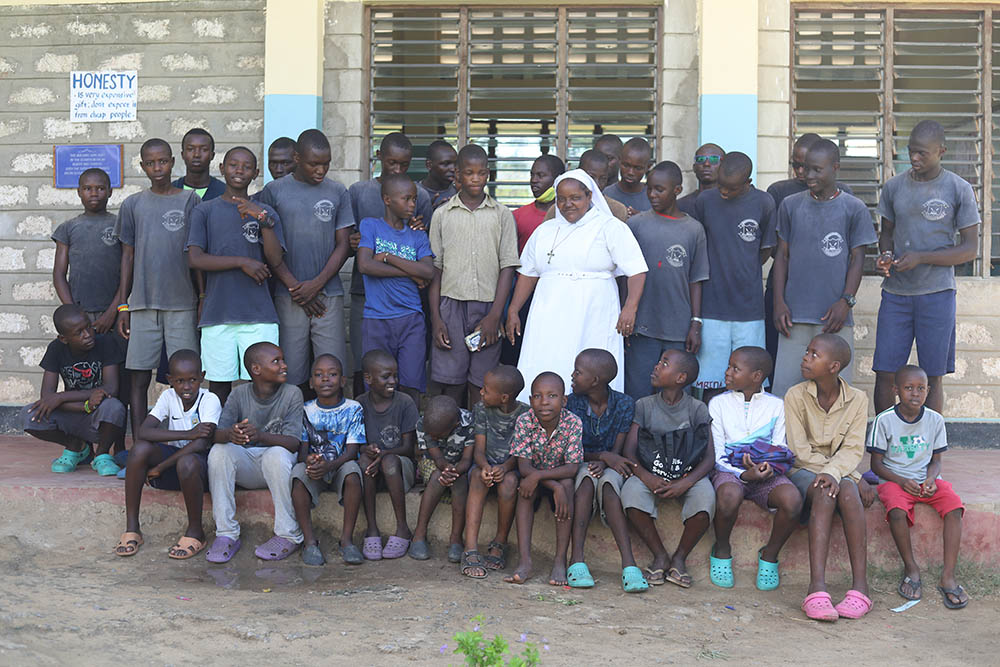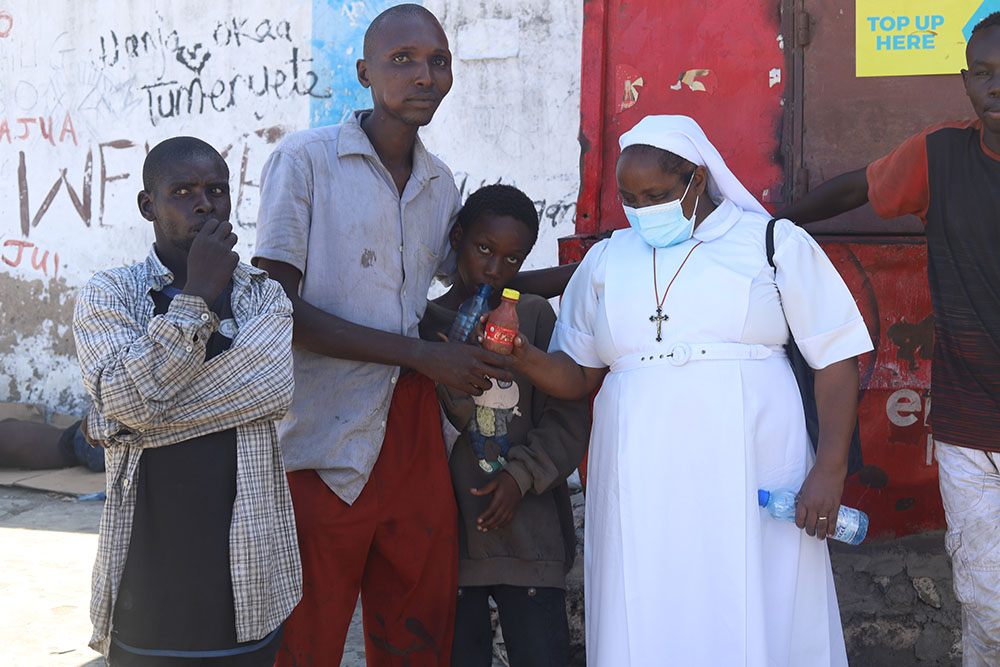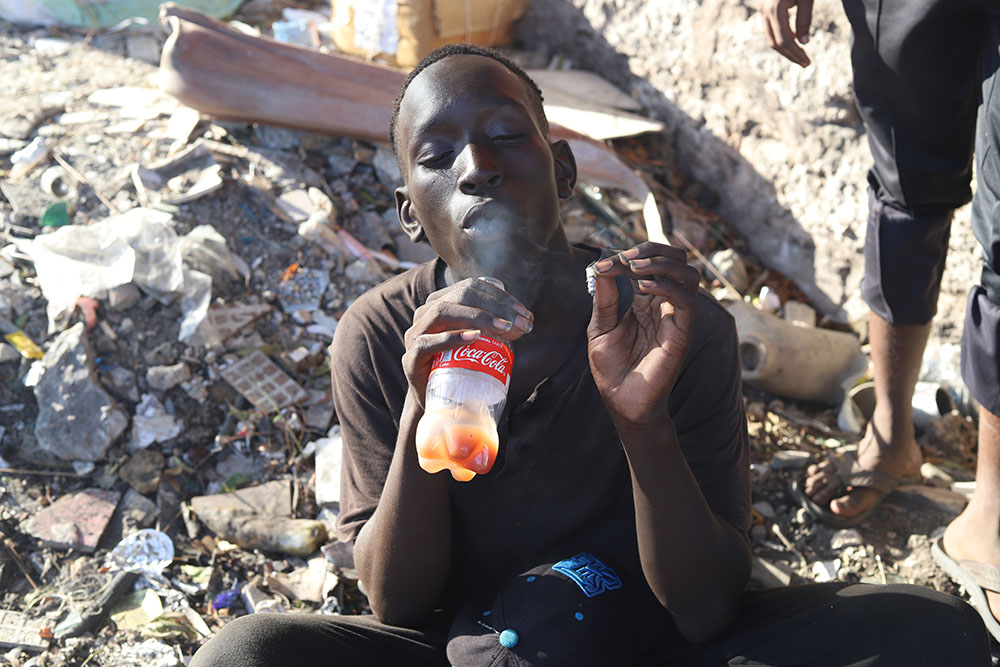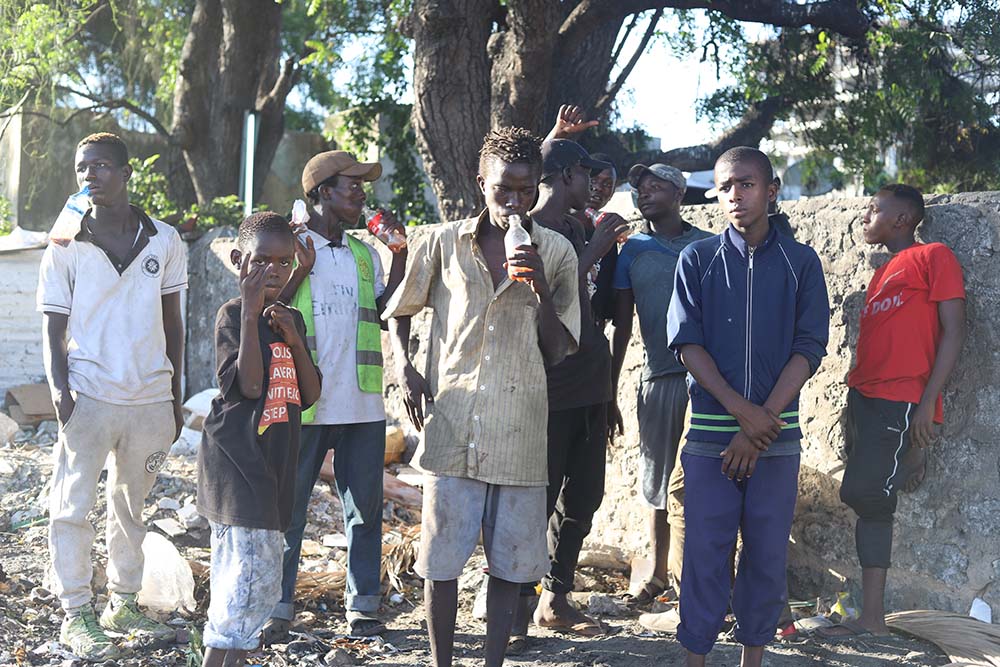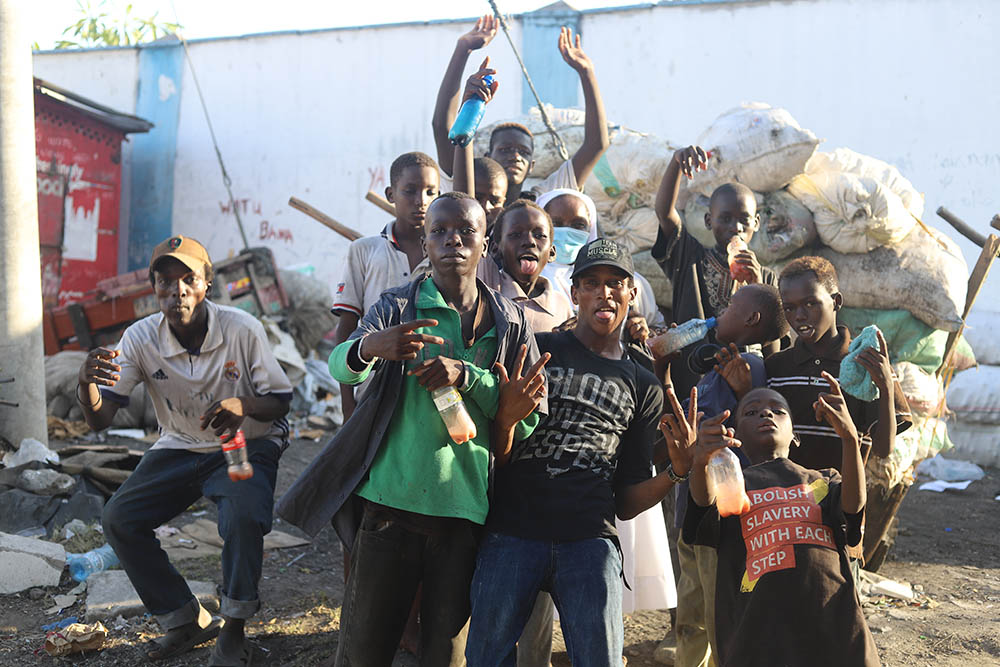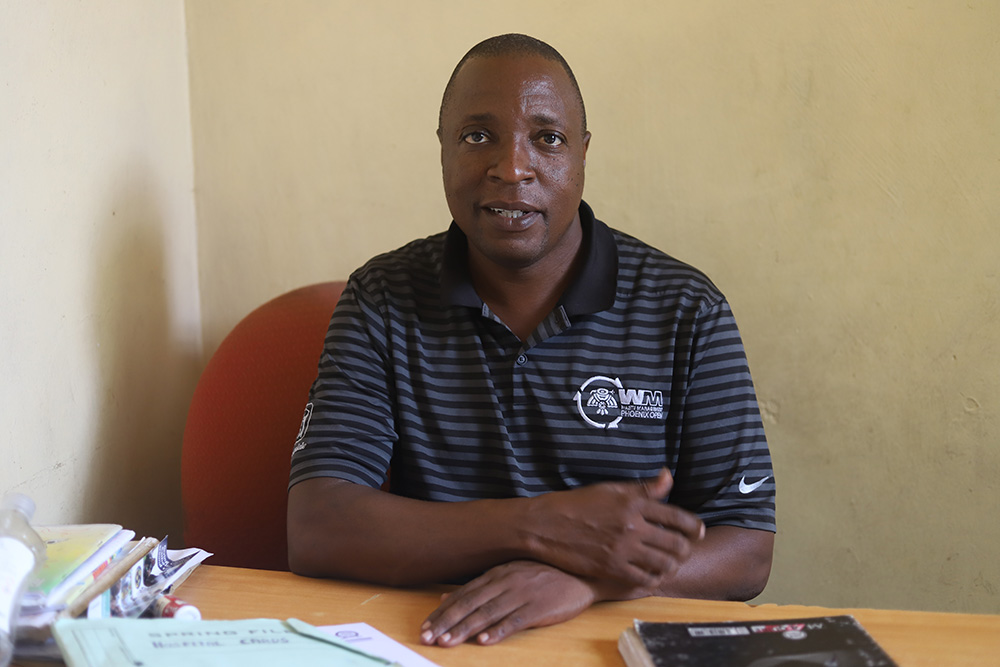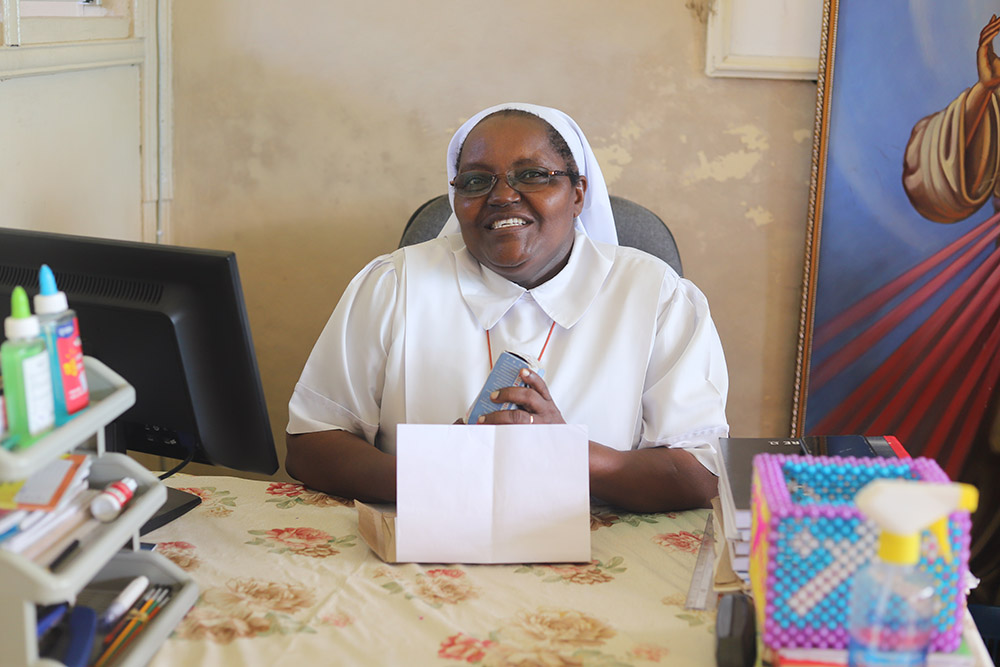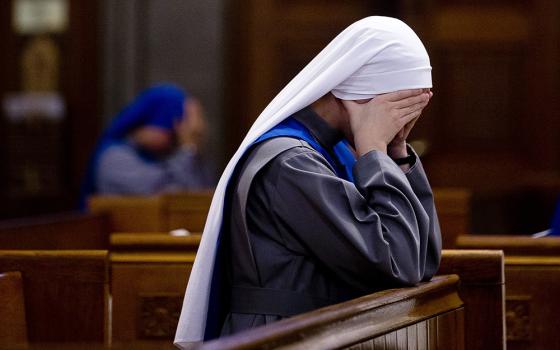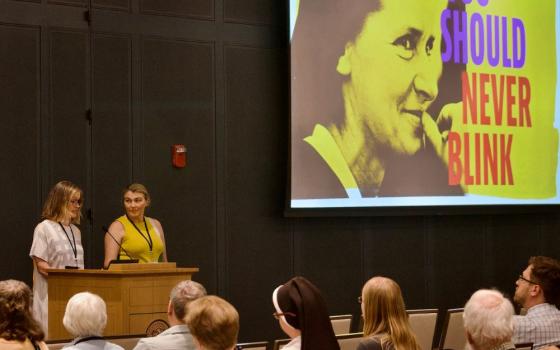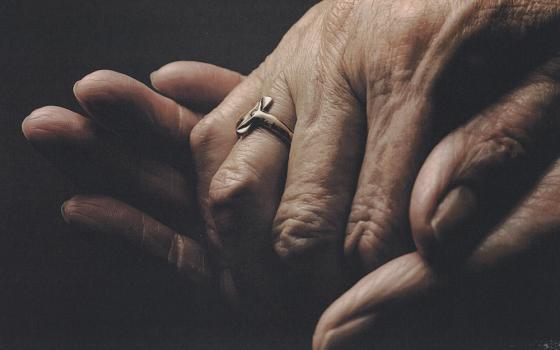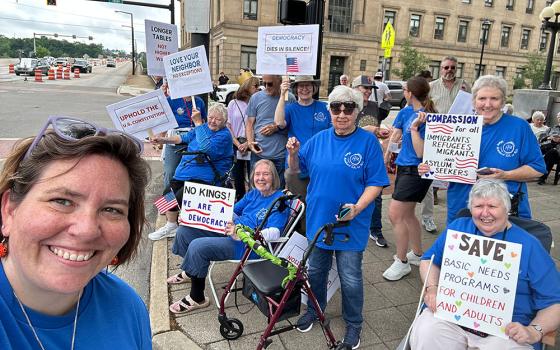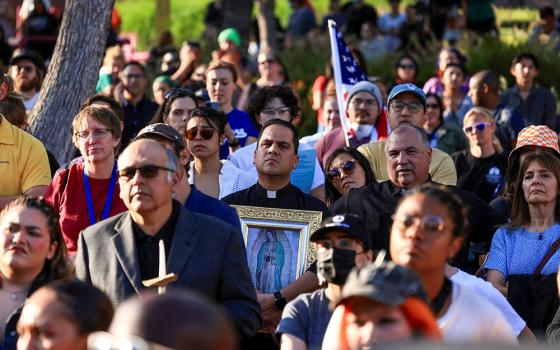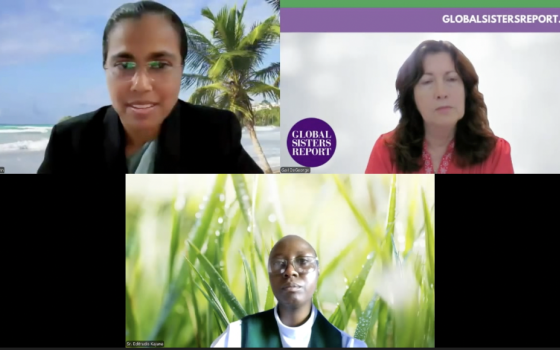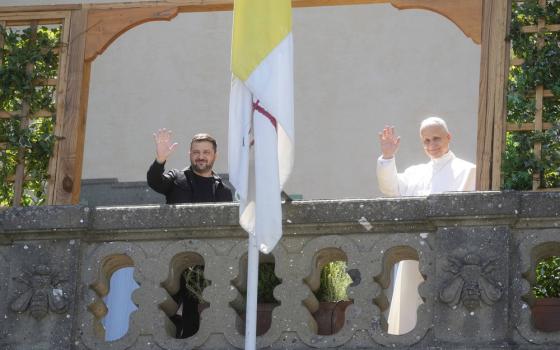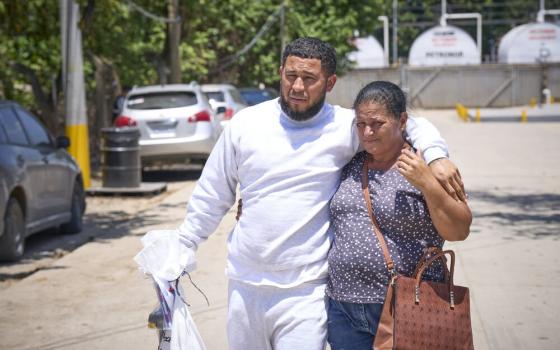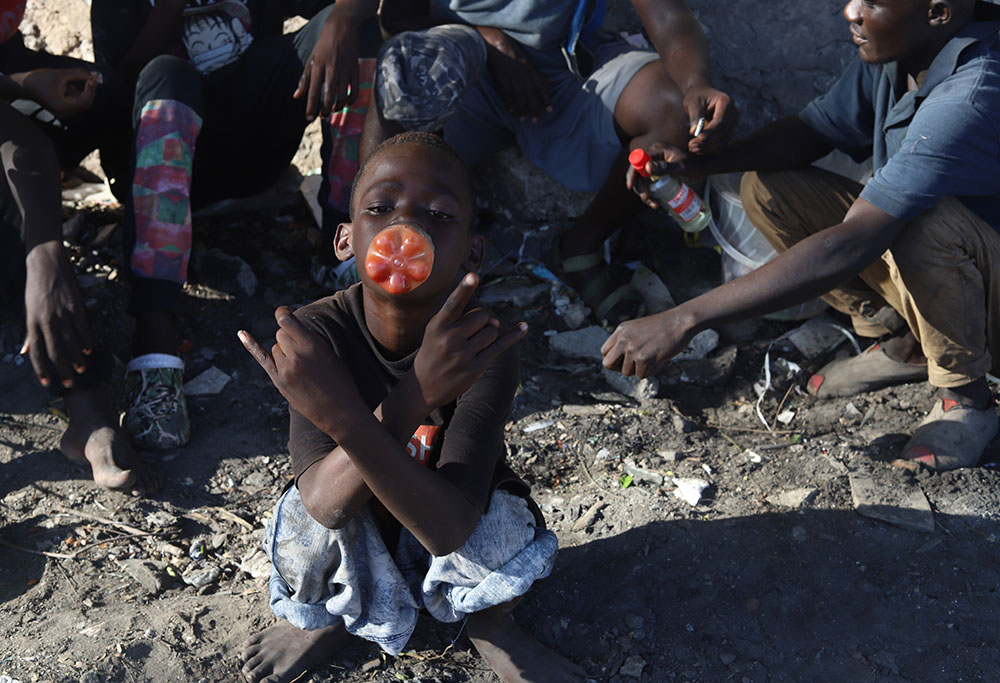
A child sniffs toxic glue from a plastic bottle on the streets of Mombasa, a coastal city in southeastern Kenya on the Indian Ocean. The high rate of youths using drugs has visibly affected their lives and the safety of the region. (GSR photo/Doreen Ajiambo)
As he looks forward to his university graduation ceremony late this year, 27-year-old Caleb Kanja can't forget his arduous journey toward his success.
In 2001, he was rescued from the streets of this coastal city in southeastern Kenya along the Indian Ocean by the Sisters of St. Joseph of Mombasa when he was using drugs, especially glue, cannabis, cocaine and heroin.
"I used every kind of drug to make me go high, and I could not fear anything while on the street," said Kanja, thanking the sisters for rescuing him from drugs and taking him to school. "The sisters helped me to be who I am today. Life was difficult on the street, and I would today be like other youths whose lives have been affected because of drugs."
Kanja, who is pursuing economics at a local university in Kenya, said he began using drugs at a tender age due to peer pressure after his mother died and left him with his uncaring father.
"I began using drugs as any other child would do in this region," he said, adding that his father was always drunk and couldn't guide him. "I ended up on the street and in dens where the addicts hide to use drugs. I used to beg for money so that I could buy glue, which is cheaper compared to other drugs."
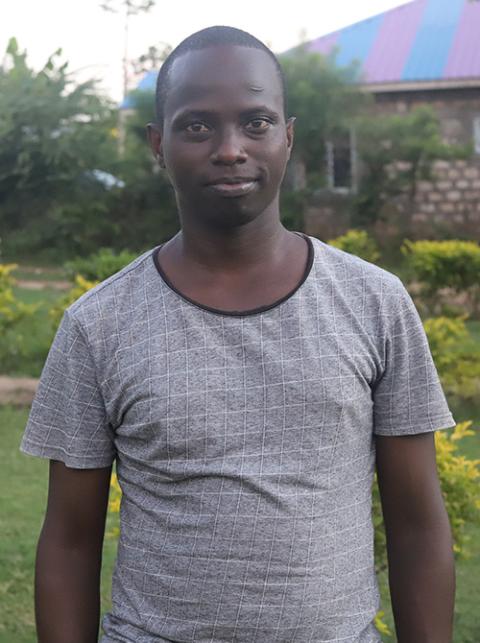
Caleb Kanja, 27, now pursuing a degree in economics at a local university in Kenya, is a beneficiary of the Grandsons of Abraham Rescue Centre in Mombasa. (GSR photo/Doreen Ajiambo)
He is among thousands of youths whom the nuns have rescued from using drugs in the coastal region. With help from volunteers, the sisters find dazed youths in abandoned buildings and shanties dotting the shores of the Indian Ocean. They take them to the Grandsons of Abraham, a rescue center that works with the community to find, rehabilitate and educate youths to make them better citizens.
The coastal region comprises six counties, which are also names of the region's main towns — Mombasa, Taita Taveta, Kwale, Kilifi, Lamu and Tana River. These towns are known as tourist destinations globally for their sun and beaches. But the tourism industry has not yielded job opportunities for many of the region's youth and young adults. Rather, tourism — and the free flow of drugs to Kenya's coast — has led to a culture that has trapped primarily boys and young men in a cycle they rarely escape.
The numbers are low for addiction among local girls and women, whose adherence to cultural norms and fear of rejection by society make it unlikely they would end up on the streets.
Findings from the country's National Authority for the Campaign Against Alcohol and Drug Abuse show that drug use is rife in the coastal regions and visibly affects the lives of youths. The report, which was released in 2016, indicates that 29.3% of coastal region residents at the time were currently using at least one addictive substance, including alcohol. In a county-by-county breakdown, Mombasa led with 34.4% of residents using at least one drug, followed by Lamu with 32%, Tana River 31.1%, Kilifi 29.7%, Kwale 26% and Taita Taveta 20.7%.
The report by the national authority, which is mandated to coordinate a multisectoral effort to prevent, control and mitigate alcohol and drug abuse in Kenya, further explains that 12.6% of residents in the coastal regions are using alcohol, 14.7% tobacco, 12% khat (a popular stimulant plant that is chewed), 4.5% bhang, 2.3% heroin, 1.3% prescription drugs, 0.9% cocaine and 0.4% hashish.
Sr. Jane Frances Kamanthe Malika of the Sisters of St. Joseph of Mombasa believes that the region's proximity to the seashore makes it a hub for narcotics, especially heroin from Southeast Asia and cocaine from Latin America destined for Europe and North America, as detailed in this 2018 research report, funded by the European Union, on "the heroin coast."
"The drugs in this region are too available, and the children get them too easily," Malika said, noting that illicit substances have addicted thousands of youths in the region. "Drugs are sold on every street here, making it easier for the youths to get them. The youths always say that the drugs help them feel high and happy so that they forget about their problems."
Government struggles
Gilbert Kitiyo, recent Mombasa County commissioner, admits that the number of people using drugs in the coastal region is high. Minors as young as 10-15 have been swept into the drug menace, he said. Kitiyo led a multi-agency security team to smoke out drug barons, midlevel dealers and street sellers. In a recent reshuffling of 24 commissioners, Kitiyo was transferred to an eastern Kenya region away from the coast.
"Drug menace in the coastal region cannot end overnight. It's a fight that is going on, and we are certain as a government we will end it," Kitiyo told Global Sisters Report in an interview last month.
Kitiyo blamed the judiciary for the slow pace of the regional war on drugs, saying thousands of cases involving drug trafficking were still pending before the Mombasa courts.
"In Mombasa alone, we make an average arrest of over 1,000 people per year with drug-related offenses, but it's now upon the judiciary to expedite court cases," he said, adding that, in most cases, they have provided enough evidence to prosecute the suspects.
Advertisement
Nevertheless, corruption by police and lack of political will have been cited as the main challenges facing the fight against drug abuse in the coastal region. In 2019, for example, a report by the United Nations Office on Drugs and Crime showed how Kenyan government officials were bribed for years by the Akasha family drug empire to shield them from legal consequences for trafficking drugs and even from extradition to the United States to face drug charges.
It took the intervention of U.S. agents of the Drug Enforcement Administration to arrest Ibrahim Akasha and Baktash Akasha, the sons of the drug baron Ibrahim Akasha. The detectives extradited them from Mombasa to New York to face charges for trying to import banned drugs.
The two were later found guilty. In January 2020, Ibrahim was sentenced to 23 years in prison for trafficking heroin and methamphetamine in the U.S. His brother, Baktash, had been sentenced to 25 years in prison in August 2019. Yet, those who aided them in Kenya remain free after authorities failed to charge them in court.
Bloodshot eyes, blemished faces
Along the streets of the coastal towns, gaunt youths can be seen seated on stones in neglected structures and shanties. Most of the youths here are a pale shadow of their former selves. Their blemished faces and skin and bloodshot eyes are the ravaged features that exaggerate their age due to constant drug abuse.
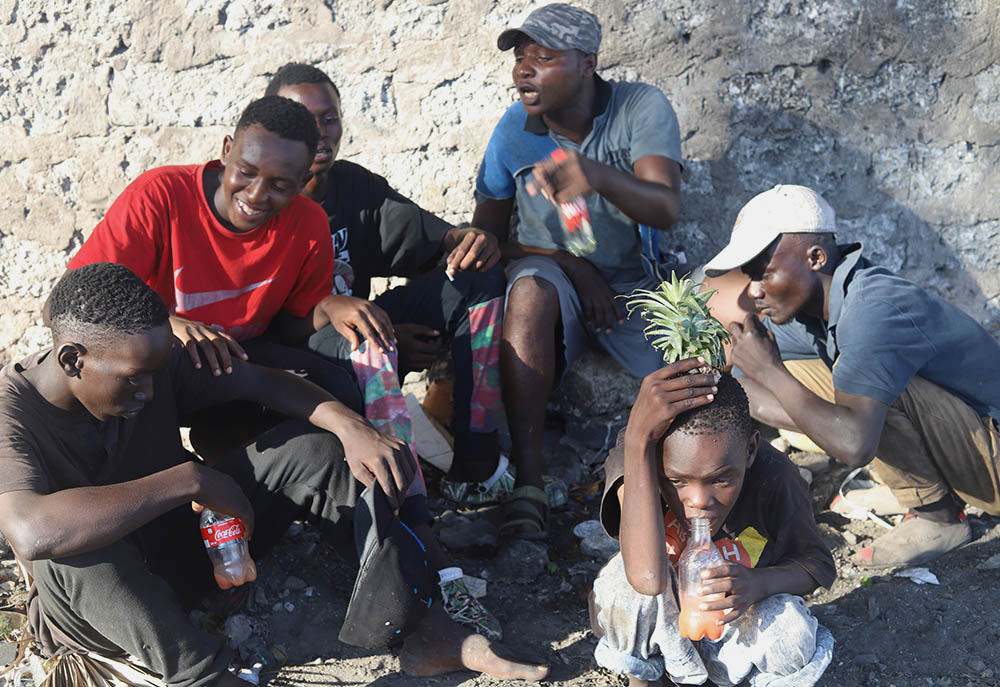
Youths meet for their daily dose of heroin, cocaine and other drug substances in Kenya's coastal region on the Indian Ocean. Addiction has become rife and is visibly affecting the lives of youths in the tourist region. However, the Sisters of St. Joseph of Mombasa are rescuing some youths from the streets, rehabilitating them before reuniting them with their families. (GSR photo/Doreen Ajiambo)
Festus Modali, one of the youths, who rolls up heroin into cigarettes or injects it directly into his veins, said his brother introduced him to drugs. "I can't live without using drugs. I will die," he said.
Pure heroin is sold to the youths and schoolchildren on every corner of these coastal region towns. The drug is smoked or snorted, but most addicts prefer injecting.
Sr. Veronica Wanjiru, a doctor who is the medical director at Mother Amadea Mission Hospital in a Mombasa suburb, said people who inject themselves with drugs were most vulnerable to HIV and viral infections such as hepatitis C.
A World Health Organization website says 23-39% of new hepatitis C infections and 10% of new HIV cases are among IV drug users. Other adverse public health consequences from those who inject drugs include risk of transmitting tuberculosis, viral hepatitis B, and several sexually transmitted infections.
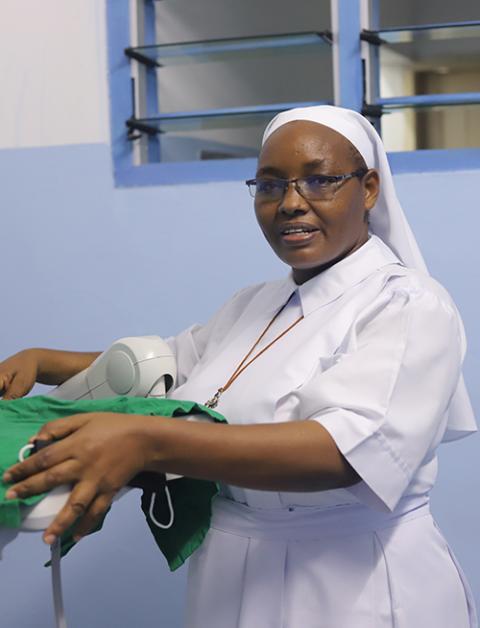
St. Joseph Sr. Veronica Wanjiru is a medical director at Mother Amadea Mission Hospital in Mombasa, Kenya. Wanjiru treats patients who struggle with substance abuse once they reach the Grandsons of Abraham Rescue Centre. (GSR photo/Doreen Ajiambo)
Health experts in the coastal region have said that drug abuse and depression are the leading causes of mental illness.
"We have the largest number of people [in the country] with mental illness due to high use of drugs, especially khat and cannabis," said Dr. Charles Mwangome, a psychiatrist at Port Reitz Sub-County Hospital in Mombasa. "The patients are all over the streets because their families have rejected some, but we are treating and rehabilitating them."
Recent Mombasa County Commissioner Kitiyo noted that the illicit drug business has contributed to lawlessness in the region, adding that youths were also dropping out of school to concentrate on consuming drugs.
"The youths are not going to school. They are busy on the streets engaging in drugs, and they are a threat to security as some engage in theft and pickpocketing," he said.
Sisters intervene
However, with the help of social workers, religious sisters are battling to end the drug menace in the coastal region. They believe that victims of drug abuse, especially youths, could still be productive in society if they are helped and rehabilitated.
The Sisters of St. Joseph of Mombasa run Grandsons of Abraham, a rescue center in Mombasa and Kilifi. They rescue addicts from the streets and drug dens and assist them in recovering from addiction before providing them with education and life skills.
Malika, the St. Joseph sister who is leading the fight against drug abuse in the coastal region, visits the dens, abandoned structures, alleys and huts where the addicts hide to smoke, sniff or inject drugs. She talks to the youths about the dangers of drug abuse and its likely consequences.
"I visit those places with social workers twice every week to talk to the boys so that they willingly come to the rescue center," she said, explaining that they give the boys a chance to decide on coming to the center themselves after persuading them about the dangers caused by substance abuse and the importance of rehabilitation.
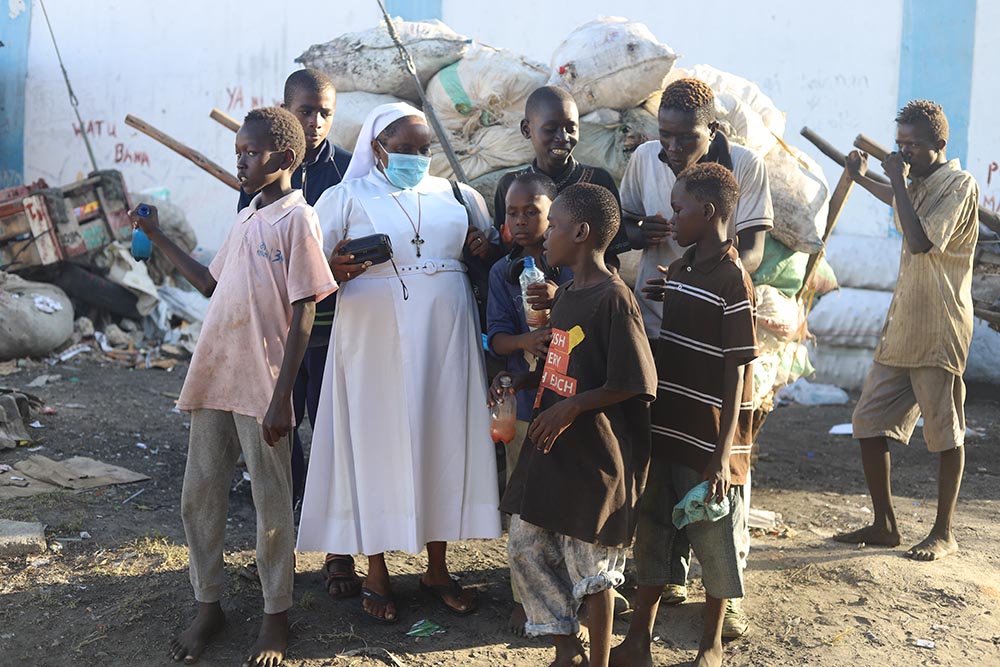
Sr. Jane Frances Kamanthe Malika puts on music from her radio to entertain children from the streets and encourage them to come to the Grandsons of Abraham Rescue Centre. The Sisters of St. Joseph of Mombasa are rescuing youths addicted to drugs from the streets, then rehabilitate them before remitting them back to their families or relatives. (GSR photo/Doreen Ajiambo)
"We don't take them by force from the streets, but we do talk to them and convince them to come on their own," Malika said. "We believe that if the decision is made by oneself, then it's from the heart, and it makes it easier for rehabilitation."
Once off the streets, the youths are given a week to rest before they begin counseling sessions and treatment. The sisters said that those who have been on drugs for a long time or are sick are taken to hospitals for treatment.
"We begin by putting these youths on medication and a healthy diet to try and flush out drugs from their system, a process that takes at least three months," said Wanjiru, whose hospital works with Grandsons of Abraham to treat drug addicts.
Malika said that after recovery, the youths are made aware of the dangers of using drugs. They provide educational scholarships to the children who are still young and willing to go back to school and complete their education. Those who can't go back are enrolled in vocational training in farming, welding, plumbing, masonry and computer skills.
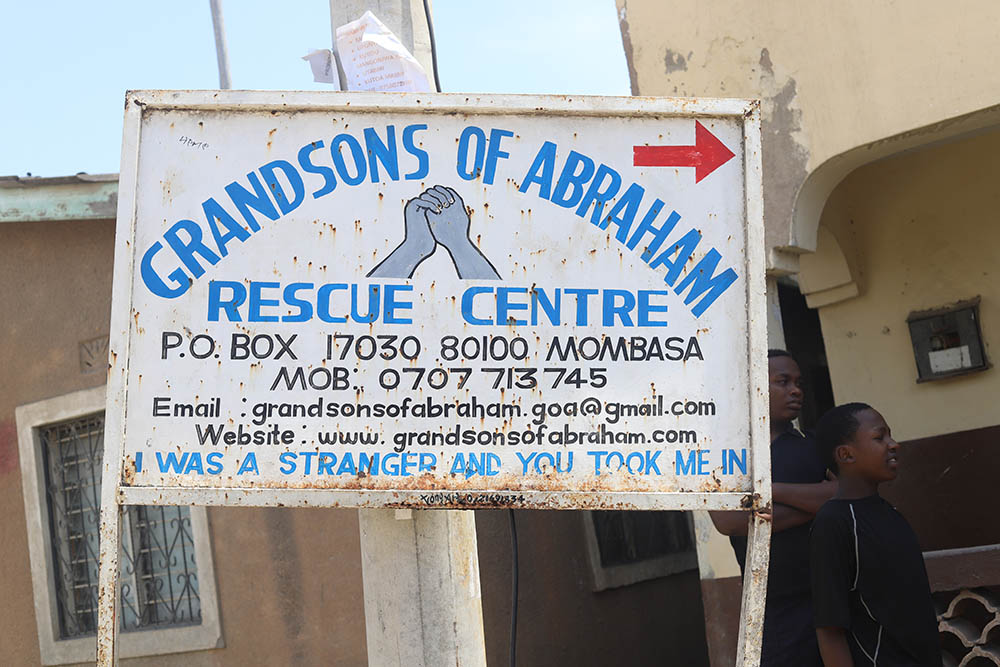
A signpost marks the Grandsons of Abraham Rescue Centre in Mombasa, a coastal city in southeastern Kenya along the Indian Ocean. The center works with the community to rescue drug-addicted street children and rehabilitate and reunite them with their families. (GSR photo/Doreen Ajiambo)
"After the child has recovered, we try to trace their families and reintegrate them back. Those who don't have families stay at our center," she said, citing challenges with the children they reintegrate into the communities.
"We have come to realize that these youths are rejected again by their families and end up in the streets," Malika conceded, adding that the sisters will try again in such cases.
The sisters have also been conducting campaigns on drugs and substances across the region's towns to educate youths on their effects and remind parents of their responsibilities. They also have engaged them in sports such as beach soccer and basketball.
"When youths engage in sports, they become busy and avoid drugs. Most of them are influenced by their peers to engage in drugs because they are idle," said Malika.
In the meantime, Kanja, the current college student the sisters pulled from the streets of Mombasa, is appealing to well-wishers to continue rescuing drug addicts, as many do not even recall how they began using drugs.
"They are innocent, and they need help," he said. "They should be assisted so that they can become better people in the society."

